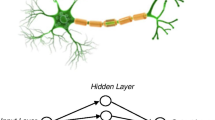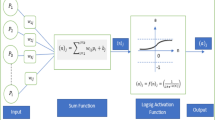Abstract
In recent times, the research on geopolymer concrete (GPC) using fly ash was performed extensively, due to its comparable properties as similar to cement and its environmental benefits. However, due to the complexity and uncertainty of the design parameters like molarity, alkaline solution concentration and liquid to fly ash (L/F) ratio had made it hard to develop a systematic mix design for geopolymer concrete. These parameters along with the properties of fly ash, curing temperature and curing time have a significant effect on compressive strength of geopolymer concrete. This paper describes the use of artificial neural network (ANN) to predict the compressive strength of the geopolymer concrete using the data obtained experimentally. The ANN is modelled using the MATLAB and thus used to predict the compressive strength using the specified input parameter. The outcomes of this research shed light on influence of curing temperature and time on compressive strength of geopolymer concrete. The developed ANN model demonstrated to be efficient tool for predicting the compressive strength with \({R}^{2}\) value of 0.85.



















Similar content being viewed by others
Data availability
Data will be made available on reasonable request.
Abbreviations
- ANN:
-
Artificial neural network
- CA:
-
Coarse aggregate
- CC:
-
Conventional concrete
- CS:
-
Compressive strength
- FA:
-
Fine aggregate
- GPC:
-
Geopolymer concrete
- ML:
-
Machine learning
- MSE:
-
Mean square error
- NTPC:
-
National thermal power corporation limited
- OPC:
-
Ordinary Portland cement
- RMSE:
-
Root-mean-square error
- SCM:
-
Supplementary cementitious materials
- XRF:
-
X-ray fluorescence
References
Gagg CR (2014) Cement and concrete as an engineering material: an historic appraisal and case study analysis. Eng Fail Anal 40:114–140. https://doi.org/10.1016/j.engfailanal.2014.02
Khozin V, Khokhryakov O, Nizamov R (2020) A «carbon footprint» of low water demand cements and cement-based concrete. IOP Conf Series Mater Sci Eng 890:012105
Akbar A, Liew KM (2020) Influence of elevated temperature on the microstructure and mechanical performance of cement composites reinforced with recycled carbon fibers. Compos B Eng 198:108245
Malhotra VM (2002) Introduction: sustainable development and concrete technology. Concr Int 24(7)
Mehta A, Siddiqu R (2017) Sulfuric acid resistance of fly ash based geopolymer concrete. Constr Build Mater 146:136–143
Davidovit J, Cordi SA (1979) Synthesis of new high temperature geo-polymers for reinforced plastics/composites. Spe Pactec 79:151–154
Nguyen KT, AhnLe NA, Lee K (2016) Theoretical and experimental study on mechanical properties and flexural strength of fly ash-geopolymer concrete. Constr Build Mater 106:65–77
Nguyen KT, Le TA, Lee J, Lee D, Lee K (2017) Investigation on properties of geopolymer mortar using preheated materials and thermogenetic admixtures. Constr Build Mater 130:146–155
Davidovits J (2015) False values on CO2 emission for geopolymer cement/concrete published in scientific papers. Tech Paper 24:1–9
Yadollahi MM, Benli A, Demirboğa R (2015) Prediction of compressive strength of geopolymer composites using an artificial neural network. Mater Res Innov 19(6):453–458
Ling Y, Wang K, Wang X, Hua S (2019) Effects of mix design parameters on heat of geopolymerization, set time, and compressive strength of high calcium fly ash geopolymer. Constr Build Mater 228:116763
Khale D, Chaudhary R (2007) Mechanism of geopolymerization and factors influencing its development: a review. J Mater Sci 42(3):729–746
Bustillo A, Urbikain G, Perez JM, Pereira OM, Lopez de Lacalle LN (2018) Smart optimization of a friction-drilling process based on boosting ensembles. J Manuf Syst. https://doi.org/10.1016/j.jmsy.2018.06.004
Arnaiz-González Á, Fernández-Valdivielso A, Bustillo A, López de Lacalle LN (2015) Using artificial neural networks for the prediction of dimensional error on inclined surfaces manufactured by ball-end milling. Int J Adv Manuf Technol 83(5–8):847–859. https://doi.org/10.1007/s00170-015-7543-y
Al-Swaidani AM, Khwies WT (2018) Applicability of artificial neural networks to predict mechanical and permeability properties of volcanic scoria-based concrete. Adv Civ Eng. https://doi.org/10.1155/2018/5207962
Bejou D, Wray B, Ingram TN (1996) Determinants of relationship quality: an artificial neural network analysis. J Bus Res 36(2):137–143. https://doi.org/10.1016/0148-2963(95)00100-x
Dao DV, Ly HB, Trinh SH, Le TT, Pham BT (2019) Artificial intelligence approaches for prediction of compressive strength of geopolymer concrete. Materials 12(6):983
Tenza-Abril AJ, Villacampa Y, Solak AM, Baeza-Brotons F (2018) Prediction and sensitivity analysis of compressive strength in segregated lightweight concrete based on artificial neural network using ultrasonic pulse velocity. Constr Build Mater 189:1173–1183. https://doi.org/10.1016/j.conbuildmat.2018.09
Artificial neural network—Wikipedia. Available from: https://en.wikipedia.org/wiki/Artificial_neural_network#cite_noteWinston-38. Accessed March 4, 2021
Jacobson L. Introduction to artificial neural networks part 2-learning 2014. Available from:http://www.theprojectspot.com/tutorial-post/introduction-to-artificial-neural-networkspart-2-learning/8. Accessed March 4, 2021
Ozcan F, Atiş CD, Karahan O, Uncuoğlu E, Tanyildizi H (2009) Comparison of artificial neural network and fuzzy logic models for prediction of long-term compressive strength of silica fume concrete. Adv Eng Softw 40(9):856–863
Yaprak H, Karacı A, Demir I (2013) Prediction of the effect of varying cure conditions and w/c ratio on the compressive strength of concrete using artificial neural networks. Neural Comput Appl 22(1):133–141
Mozumder RA, Laskar AI (2015) Prediction of unconfined compressive strength of geopolymer stabilized clayey soil using artificial neural network. Comput Geotech 69:291–300
Nazari A (2013) Artificial neural networks application to predict the compressive damage of lightweight geopolymer. Neural Comput Appl 23(2):507–518
Dao DV, Trinh SH, Ly HB, Pham BT (2019) Prediction of compressive strength of geopolymer concrete using entirely steel slag aggregates: novel hybrid artificial intelligence approaches. Appl Sci 9(6):1113
Zhang H, Li L, Sarker PK, Long T, Shi X, Wang Q, Cai G (2019) Investigating various factors affecting the long-term compressive strength of heat-cured fly ash geopolymer concrete and the use of orthogonal experimental design method. Int J Concr Struct Mater 13(1):1–18
Azevedo AGS, Strecker K, Barros LA, Tonholo LF and Lombardi CT (2019) Effect of curing temperature, activator solution composition and particle size in Brazilian fly-ash based geopolymer production. Mater Res. 22
Ling Y, Wang K, Wang X, Li W (2019) Prediction of engineering properties of fly ash-based geopolymer using artificial neural networks. Neural Comput Appl 33(1):85–100
Verma NK, Rao MC, Kumar S (2021) Effect of curing regime on compressive strength of geopolymer concrete. Earth Environ Sci 982:012031. https://doi.org/10.1088/17551315/982/1/012031
Verma NK, Rao MC, Kumar S (2022) Effect of molarity of NaOH and alkalinity ratio on compressive strength of geo-polymer concrete. Mater Today Proc 4:940–947. https://doi.org/10.1016/j.matpr.2022.03.687
Amirtharaj J, Vinod Kumar R (2018) Effect of fly ash on fiber reinforced concrete—A durability approach. Int Res J Eng Technol 5(12):643–647
Janardhanan T, Ramasamy V (2017) Improvements in the microstructural and mechanical properties of geopolymer concrete containing NMF’s of E-wastes as partial replacement of aggregates. Eur J Environ Civ Eng 1–12. https://doi.org/10.1080/19648189.2017.1357869
AASHTO M 295 (2011) Edition, 2011-Standard specification for coal fly ash and raw or calcined natural pozzolans
IS: 4031 (Part-4) (1988) Methods of physical tests for hydraulic cement-determination of consistency of standard cement paste
IS: 4031 (Part-4) (1988) Methods of physical tests for hydraulic cement-determination of initial and final setting time.
IS: 4031 (Part-4) (1988) Methods of physical tests for hydraulic cement-determination of soundness.
IS: 4031 (Part-6) (1988) Methods of physical tests for hydraulic cement-determination of compressive strength of hydraulic cement other than masonry cement.
IS: 2386 (Part-III) (1963) Methods of test for aggregates for concrete-specific gravity, density, voids, absorption and bulking
IS: 383-1970, Specification for coarse and fine aggregates from natural sources for concrete
Rachmansyah R, Hardjasaputra H, Cornelia M (2018) Experimental study of effect additional water on high performance geopolymer concrete
IS: 10262-2009, Concrete mix proportioning–guidelines
Hardjito D, Rangan B (2005) Development and properties of low-calcium fly ash-based geopolymer concrete, Res Rep. GC Faculty of Engineering Curtin University of Technology Perth Australia pp 1–94
Anandaraj S, Rooby J, Awoyera PO, Gobinath R (2019) Structural distress in glass fibre-reinforced concrete under loading and exposure to aggressive environments. Constr Build Mater 197:862–870
Maier HR, Dandy GC (2001) Neural network based modelling of environmental variables: a systematic approach. Math Comput Model 33(6–7):669–682
Azimi-Pour M, Eskandari-Naddaf H (2018) ANN and GEP prediction for simultaneous effect of nano and micro silica on the compressive and flexural strength of cement mortar. Constr Build Mater 189:978–992
Behnood A, Golafshani EM (2018) Predicting the compressive strength of silica fume concrete using hybrid artificial neural network with multi-objective grey wolves. J Clean Prod 202:54–64
IS-516–1959, Method of tests for strength of concrete.
Raijiwala DB, Patil HS (2011) Geopolymer concrete: a concrete of the next decade. Concr Solut 287
Mohd Ariffin MA, Hussin MW, Rafique Bhutta MA (2011) Mix design and compressive strength of geopolymer concrete containing blended ash from agro-industrial wastes. Adv Mater Res 339:452–457
Gopalakrishnan R, Chinnaraju K (2012) Influence of silica fume on strength characteristics of fly ash alumino silicate concrete. Proc Int Conf Adv Civ Eng 2012:165–168
Al Bakria AM, Kamarudin H, BinHussain M, Nizar IK, Zarina Y, Rafiza AR (2011) The effect of curing temperature on physical and chemical properties of geopolymers. Phys Procedia 22:286–291
Lim NHAS, Samadi M, Ariffin NF, Hussin MW, Bhutta MAR, Sarbini NN, Aminuddin E (2018) Effect of curing conditions on compressive strength of FA-POFA-based geopolymer mortar. In: IOP Conf Series: Mater Sci Eng 431(9):092007
Okoye FN, Prakash S, Singh NB (2017) Durability of fly ash based geopolymer concrete in the presence of silica fume. J Clean Prod 149:1062–1067
Al-Azzawi M, Yu T, Hadi MN (2018) Factors affecting the bond strength between the fly ash-based geopolymer concrete and steel reinforcement. Structures 14:262–272
Noushini A, Castel A, Aldred J, Rawal A (2020) Chloride diffusion resistance and chloride binding capacity of fly ash-based geopolymer concrete. Cement Concr Compos 105:103290
Padmakar M, Barhmaiah B, Priyanka ML (2021) Characteristic compressive strength of a geo polymer concrete. Mater Today Proc 37:2219–2222
Kishore K, Gupta N (2021) Mechanical characterization and assessment of composite geopolymer concrete. Mater Today Proc 44:58–62
Acknowledgements
The authors express thanks to the members of Civil Engineering Department of Guru Ghasidas Vishwavidyalaya, Bilaspur (C.G.), India, for their constant support in the completion of this research.
Author information
Authors and Affiliations
Corresponding author
Ethics declarations
Conflict of interest
Concerning the writing, and publishing of this research paper, the authors reported no conflicts. The author declares that there were no any funding agencies supporting this research.
Additional information
Publisher's Note
Springer Nature remains neutral with regard to jurisdictional claims in published maps and institutional affiliations.
Rights and permissions
Springer Nature or its licensor (e.g. a society or other partner) holds exclusive rights to this article under a publishing agreement with the author(s) or other rightsholder(s); author self-archiving of the accepted manuscript version of this article is solely governed by the terms of such publishing agreement and applicable law.
About this article
Cite this article
Verma, N.K., Meesala, C.R. & Kumar, S. Developing an ANN prediction model for compressive strength of fly ash-based geopolymer concrete with experimental investigation. Neural Comput & Applic 35, 10329–10345 (2023). https://doi.org/10.1007/s00521-023-08237-1
Received:
Accepted:
Published:
Issue Date:
DOI: https://doi.org/10.1007/s00521-023-08237-1




